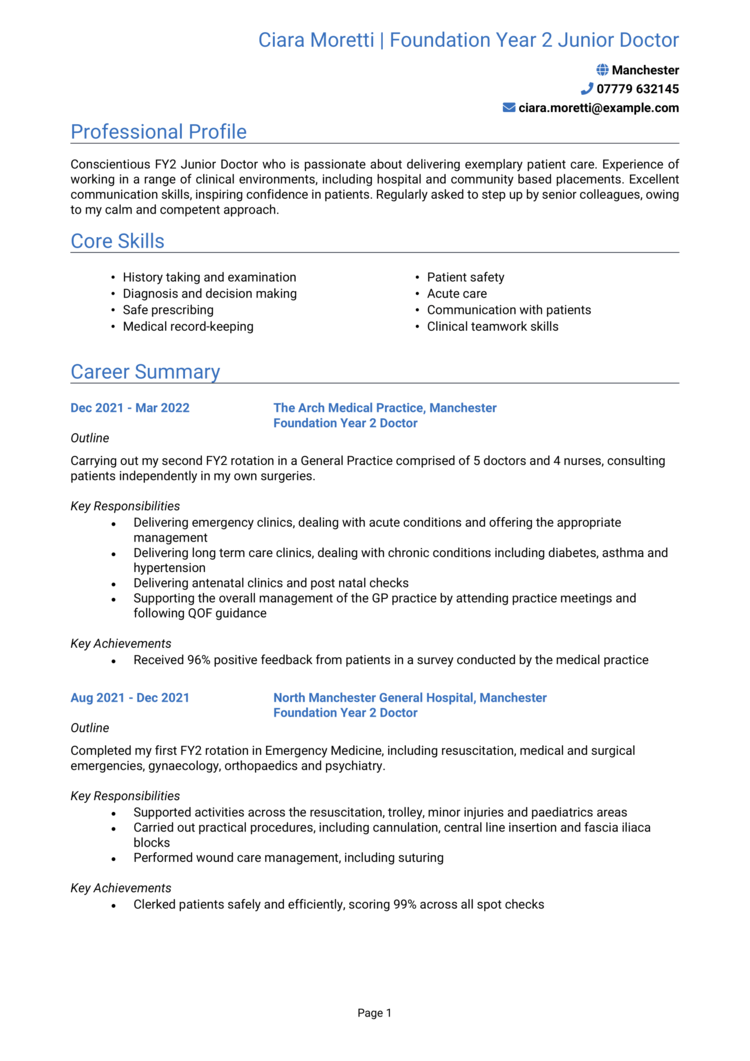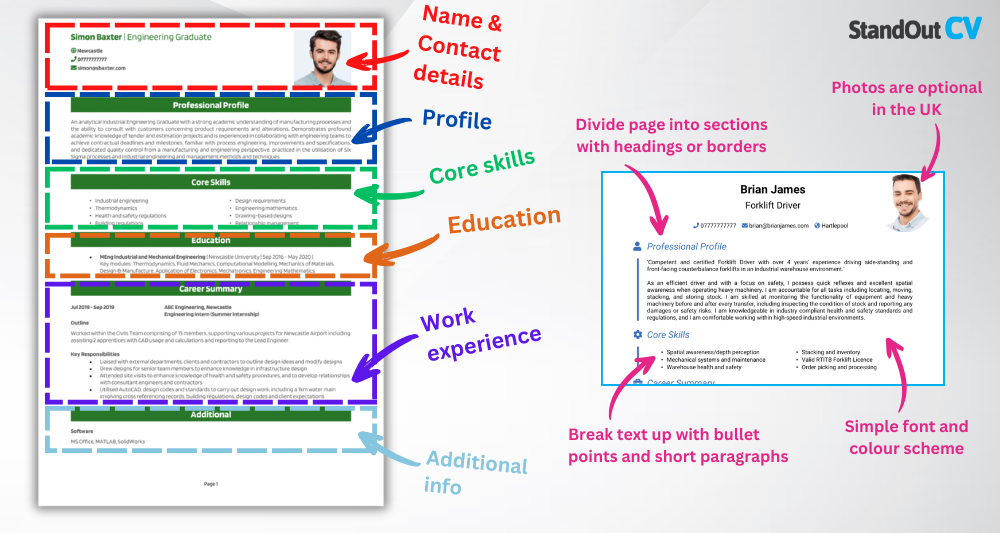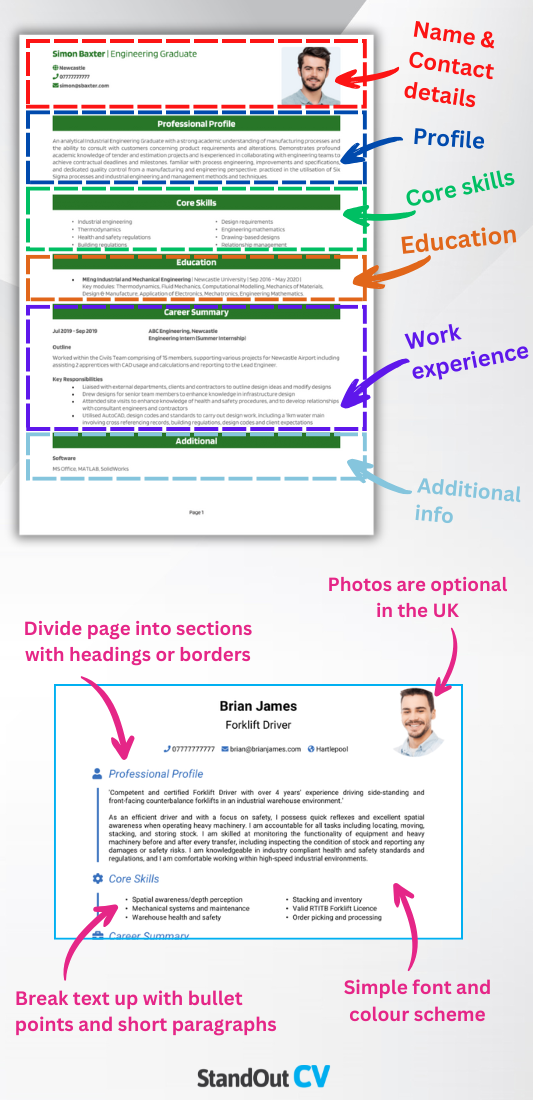You’ve made it through med school, ward rounds, and sleepless night shifts – but before you treat your next patient, your CV needs to make a strong first impression.
As a Junior Doctor, you’re expected to demonstrate professionalism and clinical competence right from the start. This guide (with Junior Doctor CV examples) will help you present your expertise in a way that reassures medical recruiters you’re more than ready to take on the pressures of the role.
Junior Doctor CV example

Foundation Doctor CV example

How to write your Junior Doctor CV
Discover how to create a quality Junior Doctor CV with this simple step-by-step guide.
Your CV needs to show more than just a list of hospital rotations. It should give recruiters confidence that you’re well-trained and ready to work effectively as part of a clinical team.
This guide will walk you through writing a CV which organises your education, work placements, and professional skills into a clear and structured document – ensuring your application stands out, whether you’re applying for an FY1 post or specialty training.
How to structure and format your Junior Doctor CV


As a Junior Doctor, attention to detail is crucial – and your CV should reflect that. Employers want to quickly understand your clinical exposure, qualifications, and interpersonal skills, so a well-organised structure is essential.
Here’s the layout to follow:
- Name and contact details – Include personal details: your name, phone number, email, and location at the top; a photo is optional.
- Profile – Open with a short summary highlighting your clinical training, strengths, and goals.
- Core skills – Bullet point your medical and transferable skills, such as communication, teamwork, or patient care.
- Work experience – List your hospital placements, shadowing, and clinical roles in reverse chronological order.
- Education & certifications – Include your medical degree, additional qualifications, and registrations.
- Additional info – Optionally list things like languages you speak, any research or publications, relevant hobbies, or related awards.
Hospitals move fast – and so do recruiters: a lengthy CV won’t hold their attention, so make sure it’s one to two pages at most. Stick with a clear, professional font, using clear headings and bullet points to enhance readability: if your format is full of mistakes, recruiters will be less likely to trust your professional expertise.
How to write a Junior Doctor CV profile


This short intro is your opportunity to show what you’ve learned, how you’ve grown, and where you’re headed in your medical career. It’s less about summarising your CV and more about showing you’re prepared for real clinical life: your CV profile should show recruiters that you’re not only well-trained, but also ready to thrive in a clinical environment.
As a junior candidate with potentially little to no experience, you should opt for a longer personal statement instead, and attach a cover letter to your CV.
Junior Doctor CV profile examples
Profile 1
Compassionate and diligent Junior Doctor with two years of clinical experience across emergency medicine, general surgery, and internal medicine rotations. Skilled in patient assessment, clinical documentation, and multidisciplinary team collaboration. Confident in managing acute presentations and providing patient-centred care in high-pressure environments. Committed to continuous learning and professional development within the NHS.
Profile 2
Highly motivated Junior Doctor with foundation training in both hospital and community settings, including acute care and psychiatry. Proficient in clinical examinations, history taking, and care planning. Experienced in using electronic health records and working within MDTs to deliver evidence-based treatments. Dedicated to delivering high-quality care with empathy and efficiency.
Things to have in your Junior Doctor CV profile
Here’s what to include:
- Medical training – Reference your medical school and year of qualification.
- Clinical exposure – Mention the variety or scope of placements or rotations you’ve completed.
- Core strengths – Touch on qualities such as decision-making under pressure or your ability to work in high-stakes, multidisciplinary settings.
- Career interests – State the kind of environment or speciality you’re looking to grow into.
- Commitment to development – Briefly express your enthusiasm for continued learning and professional growth.
What to include in the core skills section of your CV


Your core skills section offers a quick, tailored overview of the competencies you’ve built so far. It should reflect your readiness to contribute to a healthcare team, while also signalling a willingness to grow.
Focus on practical, clinical, and interpersonal skills that are relevant to junior doctor roles. Think about what you developed during placements, training, or extra-curricular involvement in healthcare settings. Avoid listing soft skills on their own – make sure each point hints at real-world application and relevance to clinical environments.
What are the most important skills for a Junior Doctor CV?
- Clinical Assessment and Diagnosis – Evaluating patient symptoms, conducting physical examinations, and forming differential diagnoses.
- Patient Management and Treatment Plans – Developing and implementing treatment strategies under senior supervision.
- Medical Documentation – Maintaining accurate, detailed patient records, discharge summaries, and clinical notes.
- Emergency Care and Resuscitation – Responding to acute medical situations, including cardiac arrests and trauma, using life support protocols.
- Multidisciplinary Team Collaboration – Working closely with nurses, consultants, and allied health professionals to deliver coordinated care.
- Medication Prescribing and Monitoring – Prescribing drugs safely and monitoring patients for efficacy and adverse reactions.
- Ward Rounds and Handover – Participating in daily ward rounds, updating care plans, and delivering thorough patient handovers.
- Clinical Procedures – Performing essential procedures such as cannulation, catheterisation, venepuncture, and suturing.
- Patient Communication and Counselling – Explaining diagnoses, treatment options, and care plans with clarity and empathy.
- Medical Ethics and Professionalism – Adhering to GMC guidelines, patient confidentiality, and ethical standards in all aspects of care.
How to list your educational history


The education section is straightforward – but crucial. Recruiters want to see that you’re fully qualified and registered (or nearly there). Start with your most recent qualification and include your medical degree, foundation training, and any relevant short courses or certifications.
Also note any postgraduate qualifications in progress or exams passed, and be sure to mention your GMC registration number if applicable.
Expand upon particularly meaningful and important modules and courses, to help compensate for your lack of practical experience.
Example education sections
Education 1
MBBS (Bachelor of Medicine, Bachelor of Surgery) | King’s College London | 2017–2023
Completed clinical rotations in general medicine, surgery, paediatrics, psychiatry, and obstetrics & gynaecology across multiple NHS Trusts. Undertook a student-selected component in emergency medicine and an elective placement in trauma care at a hospital in Cape Town, South Africa.
A-Levels: Biology (A), Chemistry (A), Mathematics (B) | Greenhill Sixth Form | 2015–2017
10x GCSEs (A*–B) | Stoneleigh Secondary School | 2013–2015
Education 2
MBChB (Bachelor of Medicine, Bachelor of Surgery) | University of Edinburgh | 2016–2022
Undertook six years of academic and clinical training, including rotations in cardiology, neurology, psychiatry, general practice, and intensive care. Completed a final-year elective in infectious diseases at a teaching hospital in Singapore. Actively involved in the university medical society and student mentorship scheme.
Scottish Highers: Biology (A), Chemistry (A), English (A), Physics (B), Maths (B) | Glenmore Academy | 2014–2016
9x National 5s (A–C) | Glenmore Academy | 2012–2014
What to include in your education section
For each qualification, add the following info:
- Qualification & organisation – State what you earned and where you earned it.
- Dates studied – Give the start and end (or intended end) month and year.
- Extra details – Expand upon specific modules which are especially related to the jobs you’re applying for, to emphasise the skills and experience you gained.
What are the best qualifications for a Junior Doctor CV?
- MBBS or MBChB (Medical Degree) – The essential qualification for medical practice in the UK.
- GMC Registration (Provisional or Full) – Confirms eligibility to practise as a doctor.
- Foundation Programme (FY1/FY2) – Evidence of practical clinical training in NHS settings.
- ALS (Advanced Life Support) Certification – Essential for emergency care preparedness.
- Additional CPD Courses (e.g. safeguarding, infection control) – Adds depth to your clinical readiness.
How to write a strong work experience section for your CV


This is where you show how you’ve applied your training in real-world medical environments. Include clinical placements, internships, shadowing, or voluntary work experience that demonstrates your readiness for the pressures of frontline healthcare.
Each placement or rotation has given you insight into patient care and hospital dynamics – show recruiters how you’ve applied what you’ve learned. List the roles in reverse chronological order, and make sure each one clearly explains where you worked, what your role was, and how you contributed to patient care and team effectiveness.
The best way to structure job entries on your CV

- Outline – Mention the hospital, ward, or department, and your position or role.
- Responsibilities – Describe what you did, such as supporting ward rounds, clerking patients, or assisting with procedures. Use action words like “monitored,” “assisted,” and “documented.”
- Achievements – Reference specific outcomes like receiving positive supervisor feedback, improving documentation processes, or taking initiative during busy periods. Here’s a tip: sprinkle some numbers wherever possible to make things more tangible.
Sample jobs for Junior Doctor
Foundation Year 1 Doctor | Stonemoor District Hospital
Outline
Completed foundation placements in general medicine, surgery, and elderly care at a busy district general hospital, delivering safe and effective patient care under supervision.
Responsibilities
- Clerked new admissions and performed regular patient reviews during ward rounds.
- Requested and interpreted investigations, including blood tests and imaging.
- Completed discharge summaries and communicated management plans to patients and families.
- Worked collaboratively with nurses, physiotherapists, and pharmacists in patient care.
- Participated in morbidity and mortality meetings and weekly teaching sessions.
Achievements
- Managed medical take shifts covering up to 30 patients per night.
- Praised for accuracy and clarity in clinical documentation.
- Recognised by supervisors for professionalism and calmness under pressure.
Medical Student Assistant | Northbridge University Hospital
Outline
Undertook FY2 rotations in emergency medicine, general practice, and psychiatry, managing a diverse patient population in both acute and community settings.
Responsibilities
- Took patient histories and conducted examinations in high-pressure A&E environments.
- Developed management plans for chronic and acute conditions in general practice.
- Completed mental health assessments and contributed to care planning in psychiatry.
- Prescribed medications and monitored treatment responses under senior guidance.
- Engaged in quality improvement initiatives and contributed to audit work.
Achievements
- Completed a successful QIP on antibiotic prescribing, leading to updated local guidelines.
- Received excellent multisource feedback for communication and teamwork.
- Supported junior colleagues during transitions into new rotations.
What to put in an additional info section


For junior doctors, the Additional Information section offers a space to show qualities that go beyond clinical placements and academic training.
It can reflect empathy, resilience, communication, and teamwork—traits essential in medical practice. It also helps paint a fuller picture of who you are as a person, not just a practitioner.
Good additional info for Junior Doctor
- Hobbies – Include activities that support emotional resilience, communication, or attention to detail—such as creative writing, mindfulness, or team sports. These show how you maintain balance and develop soft skills vital in medicine.
- Awards and Achievements – Recognition in academic settings, competitions, or extracurricular excellence can highlight dedication, leadership, and initiative.
- Extracurricular Activities – Involvement in peer mentoring, medical societies, or volunteering during medical school reflects commitment and collaboration.
- Personal Projects – Independent research, health writing, or mental health advocacy can show a proactive and socially engaged approach to healthcare.
Additional info example
Additional info
Hobbies
Mindfulness and running – Practise regular mindfulness and distance running to manage stress and stay mentally focused.
Creative writing – Explore patient perspectives through short stories, building empathy and reflective thinking.
Team sports – Played for a university netball team, developing strong communication and cooperation under pressure.
Awards and Achievements
Clinical Skills Award – Recognised for excellence in patient examination and diagnostic approach during placements.
Student Leader Award – Honoured for organising study groups and wellbeing check-ins for peers during exam season.
Extracurricular Activities
Peer mentor – Supported first-year medical students with academic and emotional guidance.
Medical Ethics Society member – Participated in debates and events exploring challenging ethical scenarios in healthcare.
Personal Projects
Public health blog – Wrote accessible articles on preventative health topics to promote community education.





